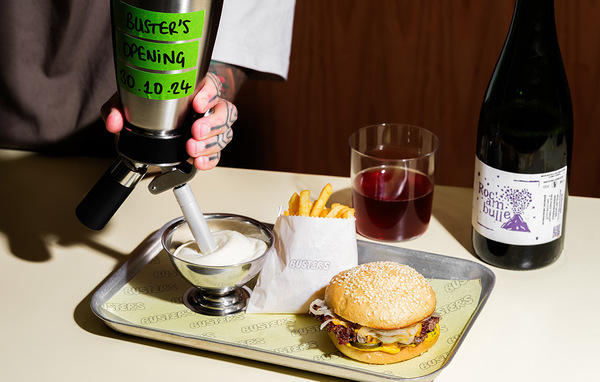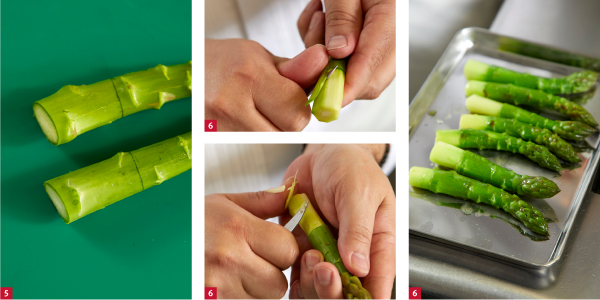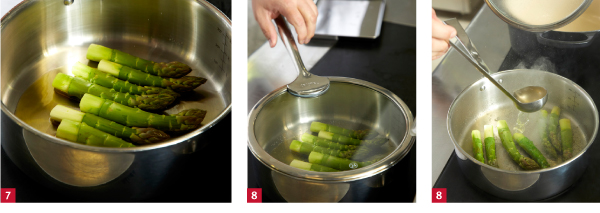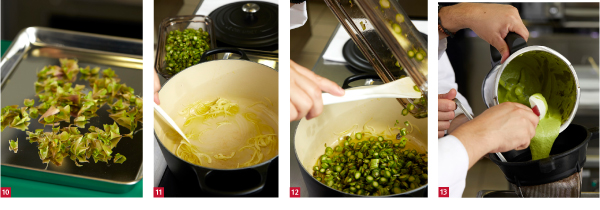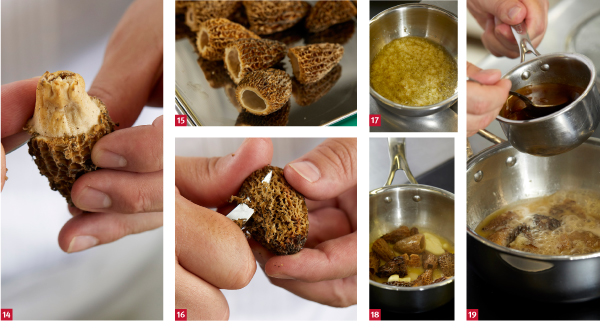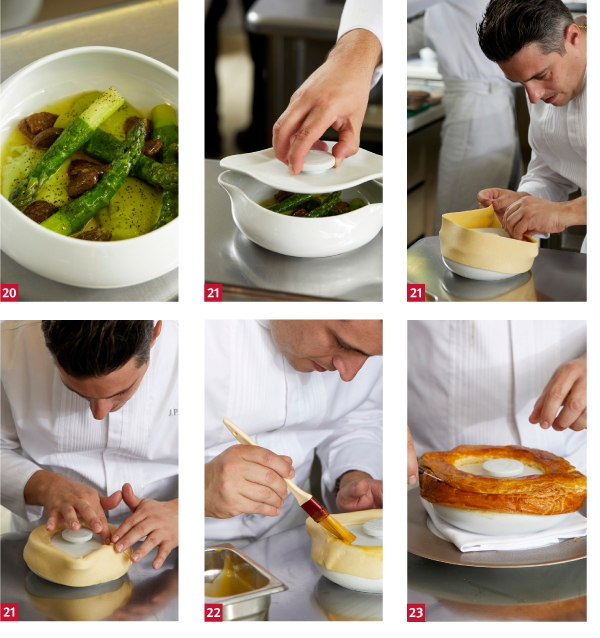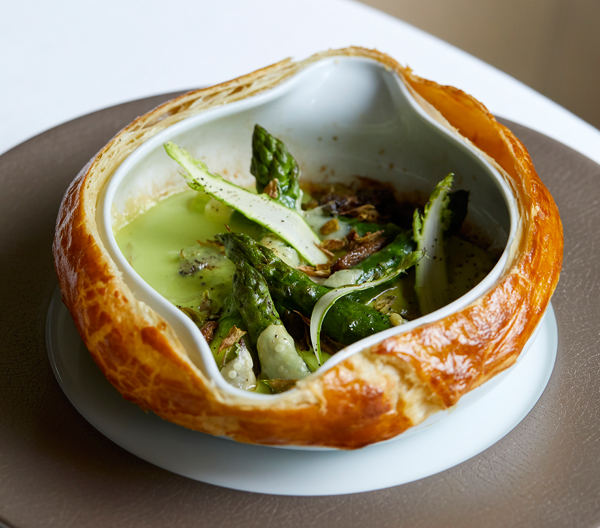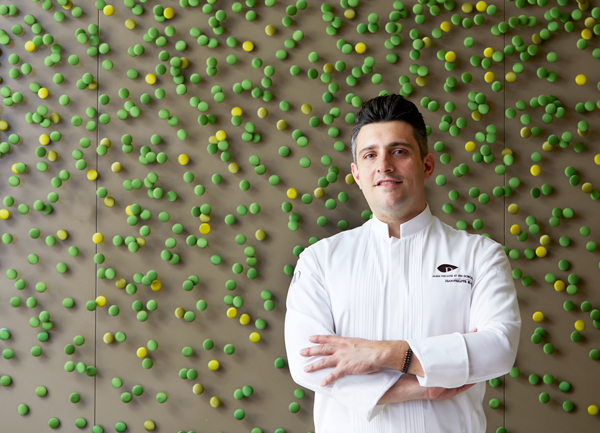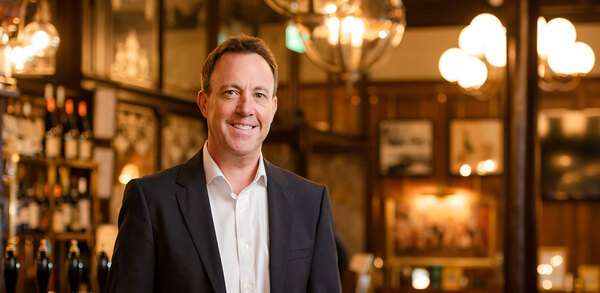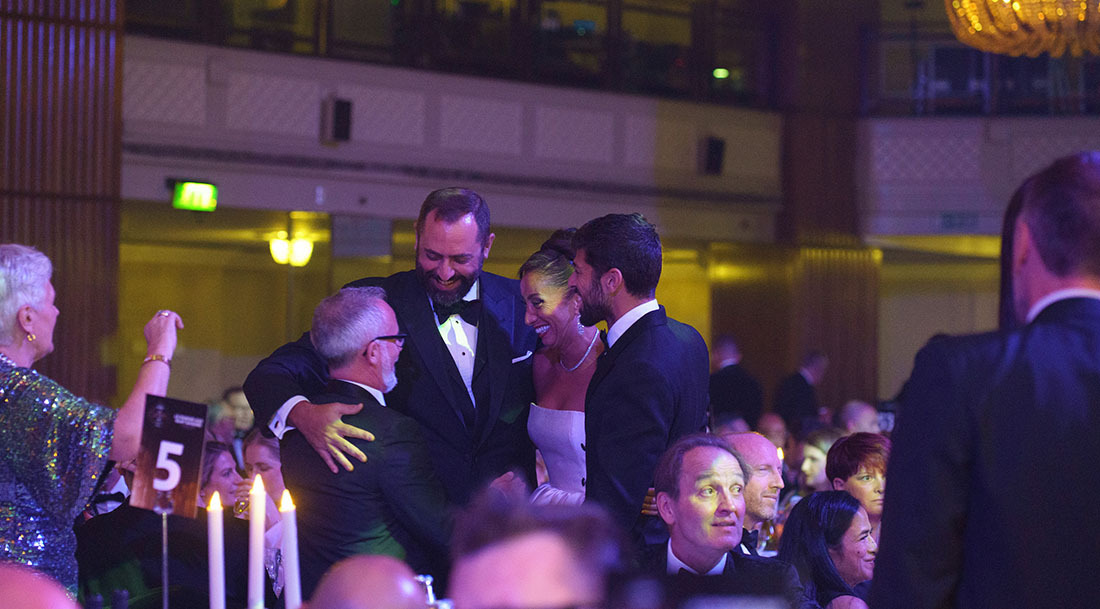Masterclass: emulating Escoffier with a morel and asparagus masterclass
Jean-Philippe Blondet's cookpot of asparagus and morel mushrooms could be straight out of Escoffier's Guide Culinaire. Michael Raffael reports
Auguste Escoffier's Le Guide Culinaire was, for most of the 20th century, the chef's bible. Its methods formed the basis of textbook teaching. As a result of its heavyweight influence, French cuisine dominated Western cuisine.
Some of its iconic gloss has faded. French gastronomy stills tops the table going by volume of Michelin stars, but it doesn't go unchallenged. Scandi, molecular and world cookery, whether from Tokyo, Bangkok, Singapore, Sydney or Lima, multiply the possibilities of devising new as opposed to derivative dishes.
Itâs what the likes of Alain Ducasse or Joël Robuchon have understood; why they can multiply their two- and three-star restaurants around the globe. Behind every menu or à la carte is a brigade of trained chefs who deliver the goods with metronomic precision.
At Alain Ducasse at the Dorchester, executive chef Jean-Philippe Blondetâs cookpot of asparagus and morels could have come straight out of Escoffierâs masterwork. The velouté, the braised wild mushrooms, the use of stocks and jus, and the technique of hermetically sealing the cookpot with pastry would all have been familiar to chefs 100 years ago.
What has shifted is the emphasis. French haute cuisine today isnât about disguising appearance or taste. Instead of transforming raw materials to display virtuosity or a chefâs command of their craft, the ingredients are the focus of a dish. Each step of the recipe has a purpose: to extract their flavours and display them to best advantage.
Planning
⢠Chicken stock, chicken jus, vegetable stock, puff pastry and shallot confit are part of the kitchenâs basic mise en place.
â¢Â Prepare the asparagus, dry the asparagus crisps and the asparagus shavings, and make the asparagus velouté.
â¢Â Preparing the morels, morel jus and morel powder.
â¢Â To order: assembling, sealing and baking the cookpots.
â¢Â To order: adding the asparagus garnishes, morel powder and extra velouté.
Cost
Alain Ducasse at the Dorchester offers £100 three-course and £120 four-course à la cartes, along with a £140 seven-course tasting menu. Blondet operates an overall 35% food cost.
Preparing the asparagus
A batch is based on approximately 2kg of asparagus â" around 40 spears â" and will make 10 portions. Asparagus size of 22mm-26mm relates to the minimum diameter at the base of the spears. Snap off the woody ends of the asparagus and discard them. This will leave spears about 20cm long (1).
With a paring knife, trim the scales off the stems and reserve for the asparagus crisps (2). Cut off the bottom 5cm and slice it into thin rings for the velouté (3) (the kitchen will make a double batch).
On a Japanese mandolin, shave 10 asparagus spears lengthways as finely as possible into a container of iced water** (4)**. These are for the garnish.
Trim the remaining spears: make a thin cut all the way around each stem about 5cm from the end (5) and pare away the green skin (you can add the peelings to the velouté) (6).
Cooking the asparagus
Based on eight pieces for the photography, but scale up as necessary for a full batch size.
50ml mild Ligurian extra virgin olive oil
8 trimmed asparagus spears
150ml approx chicken stock
Salt
Heat the oil in a sauté pan large enough for the asparagus to lie flat (7). Add them and sweat over a low to medium heat for four minutes. Add the stock (8), season very lightly, cover the pan with a lid and stew gently until tender (9). Chill the spears ahead of service.
Asparagus crisps for garnish
Lay the pared scales in a flat layer on a tray (10) and either dry them out till they are crisp in a dehydrator or in an oven overnight at 60°C. Store them in a sealed container.
Asparagus purée/velouté
120ml extra virgin olive oil
1 large sliced white onion
1kg finely sliced asparagus rings
500ml vegetable stock
Salt
Heat 80ml oil in a pan. Sweat the onions till they start to soften (11). Add the asparagus rings, 300ml vegetable stock and salt (12). Cover and simmer gently until the asparagus is soft but hasnât lost its colour. Purée with the remaining oil and stock in a Thermomix and pass through a fine sieve (13). Chill and reserve.
Preparing the morels
Based on a 500g batch size, reduced to 150g for the photography
500g fresh morels
70g shallot confit (see below)
1 litre chicken stock
200ml chicken jus
Salt and black pepper
To make the shallot confit: sweat 100g finely diced banana shallots in 100ml olive oil. Add 200g unsalted butter and leave to stew at the side of the range without colouring for about an hour.
Cut off the ends of the morels to remove any attached soil. Cut off the stems at the base of the caps (14-15), reserving the parings for the morel powder. Using a razor-sharp paring knife, trim the surface of the caps and keep the trimmings for powder (16). Wash the caps and trimmings in separate waters and drain them.
Heat the shallot confit gently (17). Add the morel caps and stew for 10 minutes (18). Pour over a third of the stock, boil and reduce (19). Repeat the process twice more. This takes about 25 minutes. Add the jus, cover and simmer for 20 minutes. Strain the morels and reserve. Retain the liquid.
Morel powder
Dry all the morel trimmings in a dehydrator or at 60°C in the oven overnight and grind to a powder in a mortar.
Preparing and baking the cookpot
Per portion
The kitchen uses a lidded Pillivuyt cookpot for the dish. The cookpot is Alain Ducasseâs signature dish, created in collaboration with designer Pierre Tachon.
50g asparagus velouté
3 trimmed and cooked asparagus spears
7 cooked morels
Around 50ml morel cooking jus
1 strip puff pastry (about 35cm x 5cm)
Egg wash â" yolk only
Preheat a forced convection oven to 190°C. Put three mounds of velouté in the base of the cookpot and lay an asparagus spear on each. Add the morels and their jus (20).
Put the lid on the pot and wrap the puff pastry around it to seal in the contents (21). Brush with egg wash and bake for seven minutes (22).
Finishing and serving
In the kitchen, cut through the baked pastry around the rim and remove the lid (23). Add a sprinkling of morel powder, some asparagus crisps and three or four asparagus shavings. Slice aged Comté cheese (from the French Alps) and put a piece over each asparagus spear. Replace the lid.
Heat a jugful of asparagus velouté with enough stock left from cooking the spears to thin it to a pouring consistency. Serve the lidded cookpot and then pour the velouté over the asparagus and morels (24).
Jean-Philippe Blondet Fourteen years ago, fresh out of hotel school, Jean-Philippe Blondet applied to Alain Ducasse for a job. He drew a blank at his first choice, the Louis XV-Alain Ducasse à lâHôtel de Paris in Monte Carlo, â¨but the company hired him as a commis at its London outpost, Spoon. Today heâs executive head chef of Alain Ducasse at the Dorchester, one of a trio of three-Michelin-starred restaurants under the Ducasse umbrella.
His rise typifies the way the French company grooms and rewards those working for it. â¨After his initial two years in London, Blondet asked to switch from the modern bistro ethos â" where he had risen to chef de partie â" to a formal gastronomic restaurant.
The answer came back, he recalls, from Pascal Féraud, then head chef of Spoon at Sanderson, and Vincent Lung, recruiting for the company. âThey said, âYou can start at the Louis XV but you have to be there in a week.â I went âboomâ and I was a commis again. Back then everybody there had basic skills and maybe now itâs a bit less.â
It isnât, he insists, a change for the worse. âWhen you employ somebody who has acquired skills, itâs harder to make them adapt. A 25-year-old commis doesnât easily change from chopping tomatoes the way he has learned to doing it the way the restaurant wants him to.â
What Blondet gained from his time there was an understanding of the rigorous disciplined approach to every task and the passionate care for the quality of the produce.
Two years down the line, Blondet asked for a chance to move again, this time to Japan. The answer came back that he wasnât ready. âThey said, âWhen you know how to cook, then youâll go there, but â¨at the moment you donât know anything â" youâre too young.ââ
Instead, he followed the Louis XV sous chef to a Relays & Châteaux in Provence and then Benoit, a Ducasse-owned bistro in Paris. âUntil then, I didnât know how to make a pâté; how can you be a chef and not know how to make one?â
The next rung up the ladder was as number two in Hong Kong at Spoon, a two-Michelin-starred restaurant that had evolved beyond the original Spoon concept.
Within Alain Ducasse, he confirmed, nothing changed without the approval of head office. If the chef wanted to put a new dish on the menu, he had to run it by the corporate chef. âOf course, you have your individual personality as a chef,â he says, âbut you have to remember you are cooking for somebody else: the customer.â
He returned to London and Alain Ducasse at the Dorchester in 2013 as its senior sous chef before taking over the kitchens from Jocelyn Herland in January 2016. With 26 chefs aged between 18 and their mid-twenties in his kitchen, he has kept the office work to a minimum. His routine, he claims, focuses on training and honing house skills, but also on teaching members of his brigade to fine-tune their palates.
Is the cooking here the same as at Alain Ducasse au Athénée or Le Meurice-Alain Ducasse (Ducasseâs three- and two-Michelin-starred restaurants in Paris)? London customers, he says, donât want to eat the same things as their Parisian counterparts. âEach one has its own stamp.
All the restaurants in the group are different [which helps to explain why so many of those working for him stay]. Yes, they share the same techniques or the same approach to the produce, cooking and seasoning, but each one has its own personality.â


